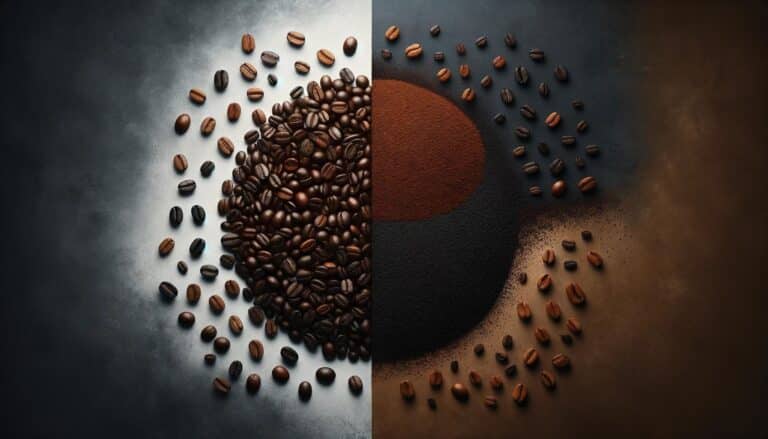Millions of people around the world love iced coffee, a refreshing drink with a long history that goes back centuries. It connects with many different cultures and changes in cooking traditions. This cool drink changes warm traditional coffee into something you can enjoy on a hot day. Over time, iced coffee has changed to fit any season, but it’s especially great in hot weather and summer.
What is an Iced Coffee?
Iced coffee is a cold beverage made from brewed coffee served over ice, offering a cool alternative to hot coffee. It’s a popular choice, especially in warmer climates or during hot weather, as it offers the rich taste of coffee in a chilled form. Iced coffee can be customized with a variety of additives like milk, cream, sugar, flavored syrups, or even spices, allowing for a wide range of flavors and textures.
Brief History of Iced Coffee
People are not quite sure where iced coffee came from, as many cultures say they were the first to make cold coffee drinks. History shows that people started making different kinds of iced coffee in the 17th century. Japan is one of the first places where they documented making coffee cold on purpose, back in the 17th century. In Europe, people in France made something similar in the 19th century called Mazagran. This was a cold coffee mixed with sugar and water, sometimes lemon, and served in a tall glass.
As coffee became easier to get and more popular all over the world, iced coffee moved from being something new and different to a regular choice. The 20th century was important for iced coffee because companies started making it on a large scale. They came up with new ways to brew and serve it, which made more people like it. Today, you can find all sorts of iced coffee, from simple to fancy, showing how much people still enjoy it.
Explanation of its Popularity, Especially in Warmer Climates and Seasons
People love iced coffee, especially in hot places, because it cools them down and can change to fit many tastes. In hot countries, like those in Southeast Asia and parts of Latin America, iced coffee is more than just a drink. It’s part of the culture, offering a cool break and a caffeine boost.
When summer comes, and it gets hot, even in cooler places, everyone starts drinking more iced coffee. It’s perfect for the season. As it gets warmer, fans of coffee switch from hot to cold drinks to stay cool. Iced coffee is great because you can mix it with different flavors, milks, and sweeteners, making it popular with lots of people, no matter what they like to eat or drink.
Also, iced coffee isn’t just for summer anymore. Many coffee shops and cafes serve it all year because we have better fridges and ways to make coffee now. Plus, people think of coffee as more than a drink; it’s part of an experience. Social media has helped make iced coffee even more popular, showing it off as a cool drink that’s good for any time.
To sum it up, iced coffee has come a long way. It’s not just a cold drink anymore; it’s a big part of modern cafe culture. Whether you need a boost in the morning, a treat in the afternoon, or something sweet at night, iced coffee is a favorite for its taste and the cool refreshment it offers.
What is Iced Coffee?
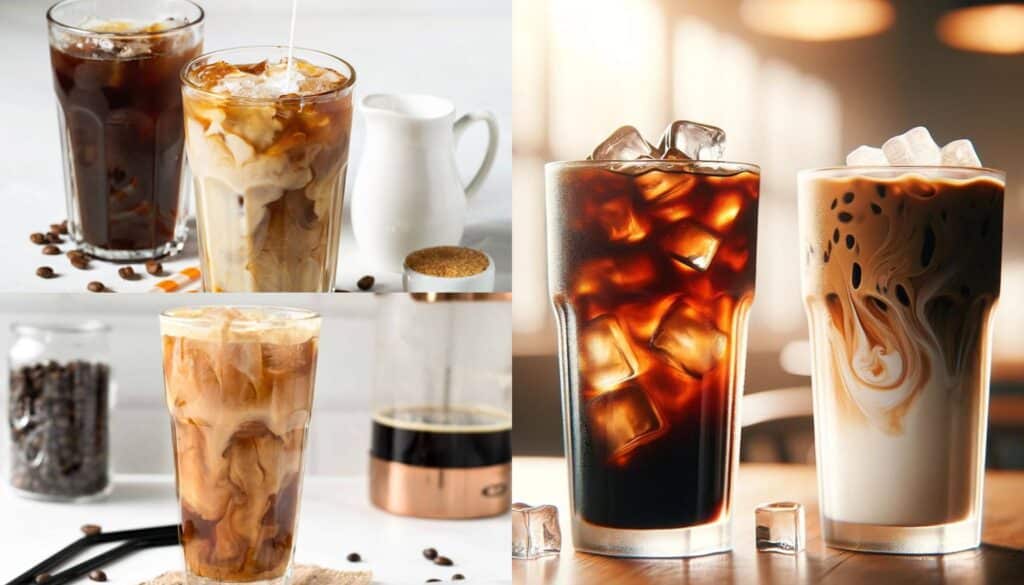
Basic Definition
Iced coffee is a refreshing beverage made by cooling brewed coffee and then serving it over ice. Typically, it starts with a strong brew—often stronger than standard coffee—to prevent the drink from becoming too diluted when the ice melts. Iced coffee can be served plain or with a variety of additives such as milk, cream, syrups, or sweeteners to enhance its flavor. Its simplicity and versatility make it a popular choice for coffee enthusiasts and casual drinkers alike, especially during warmer months.
Key Differences Between Iced Coffee and Other Cold Coffee Drinks
While iced coffee is a broad category, it’s distinct from other popular cold coffee beverages like cold brew, frappuccino, and iced latte. Understanding these differences is key to appreciating the unique qualities and preparation methods that each drink offers.
Iced Coffee vs. Cold Brew
- Brewing Process: The primary distinction lies in the brewing process. Iced coffee is made by brewing hot coffee in a conventional manner and then cooling it down, usually by pouring it over ice. Cold brew, on the other hand, is made by steeping coffee grounds in cold water for an extended period, typically 12 to 24 hours, resulting in a smoother, less acidic taste.
- Flavor Profile: Iced coffee retains the acidity and full-bodied flavor of its hot counterpart but cooled down. Cold brew is known for its smooth, mild flavor profile, with less bitterness and acidity due to the cold extraction process.
- Caffeine Content: The caffeine content can vary, but cold brew generally has a higher concentration of caffeine compared to traditional iced coffee due to its longer brewing time and often higher coffee-to-water ratio.
Iced Coffee vs. Frappuccino
- Composition and Texture: A frappuccino is a trademarked beverage of Starbucks, characterized by its blended ice drink texture, combining coffee or another base ingredient with ice, sugar, and various syrups or flavorings, often topped with whipped cream. It’s more of a coffee-flavored milkshake than a traditional coffee drink.
- Flavor and Customization: Frappuccinos are known for their sweetness and wide range of flavors and customizations, which can include everything from chocolate and caramel to fruit and spice. In contrast, iced coffee offers a more straightforward coffee flavor that can be adjusted with milk or sweeteners but typically focuses on the coffee itself.
Iced Coffee vs. Iced Latte
- Milk Content: An iced latte involves a significant amount of milk, with espresso poured over ice and then topped with cold milk, leading to a creamier texture and milder coffee flavor. Iced coffee, while it can contain milk or cream, does not have milk as a dominant ingredient.
- Espresso vs. Brewed Coffee: Iced lattes are made with espresso, which gives them a different flavor profile and caffeine kick compared to iced coffee, which is made with brewed coffee.
In summary, while all these beverages share the common element of being served cold, their preparation methods, flavor profiles, and textures vary greatly, catering to a wide range of tastes and preferences within the coffee-drinking community.
The Origin of Iced Coffee
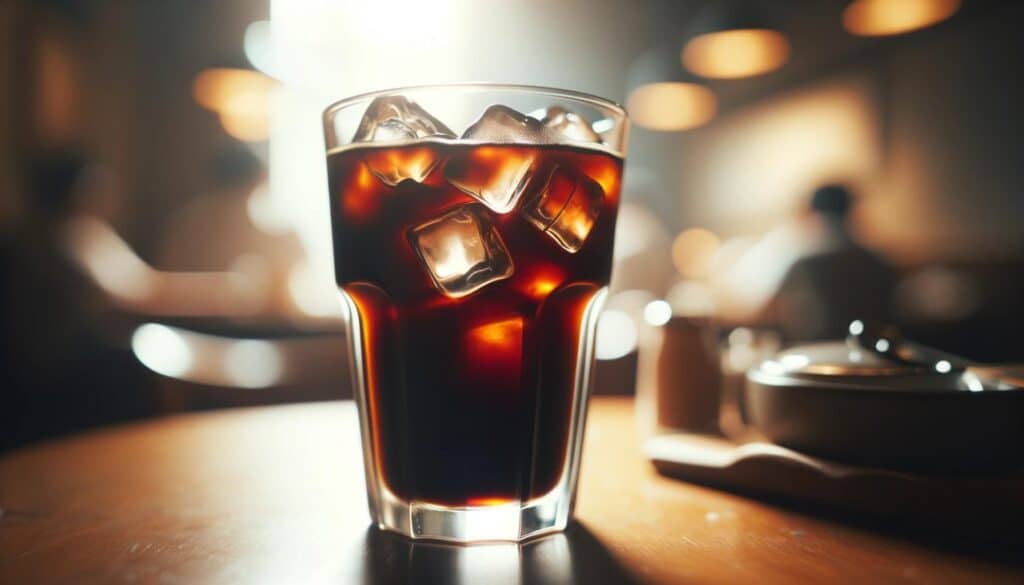
Historical Background
The story of iced coffee is as fascinating and varied as the drink itself, stretching back centuries to when different cultures began experimenting with cold coffee recipes. Figuring out exactly where iced coffee started is hard, but its history shows how coffee traveled the world, becoming a key part of many cultures.
Back in the 17th century, one of the first times people recorded drinking coffee cold was in Algeria, with a drink called Mazagran. French soldiers at the Mazagran fortress made it with coffee syrup and cold water. They took this recipe back to France, and it turned into a well-liked café beverage that people sometimes enjoyed with lemon and even rum.
By the 19th century, as coffee farms popped up in hot, tropical areas, the idea of cold coffee drinks caught on as a way to cool down. In places like Latin America and Southeast Asia, local versions of iced coffee started to appear, each adapting to the ingredients and flavors available locally.
Geographic Origins and How Different Cultures Have Influenced Its Evolution
Japan: Japan has a unique tradition of serving coffee cold that dates back to the 1920s. The Japanese method involves brewing coffee hot and then instantly cooling it, which preserves the coffee’s flavor and aroma. This technique laid the groundwork for what many aficionados consider a superior method of making iced coffee.
Greece: The frappe, invented in the 1950s, is a hallmark of Greek coffee culture. It was created using instant coffee, water, and ice, resulting in a frothy, refreshing drink that became a national staple, especially during the hot summer months.
Vietnam: Vietnamese iced coffee, or cà phê đá, is a distinctive and bold drink made from dark roast coffee dripped through a metal filter into a glass with sweetened condensed milk and then poured over ice. This method showcases the adaptation of French coffee traditions with local flavors and ingredients, resulting in a rich and creamy coffee drink that has gained international popularity.
Italy: Though Italy is famed for its hot espresso, it also has a tradition of serving coffee cold, especially in the form of the shakerato. This Italian iced coffee is made by vigorously shaking espresso and ice (sometimes sugar) in a cocktail shaker until frothy and chilled, then served in a chilled glass.
United States: The popularity of iced coffee in the U.S. surged in the late 20th and early 21st centuries, with the rise of coffee chains and the introduction of cold brew coffee. The American take on iced coffee often involves a variety of flavors, sweeteners, and milk options, reflecting the country’s penchant for customization.
These diverse origins and traditions highlight how iced coffee has been adapted and reinvented across different cultures, each adding its unique touch to the beverage. From the simple mixing of coffee with ice to more elaborate preparations involving brewing techniques and additives, the evolution of iced coffee mirrors the dynamic and interconnected history of coffee consumption around the world.
How Iced Coffee is Made
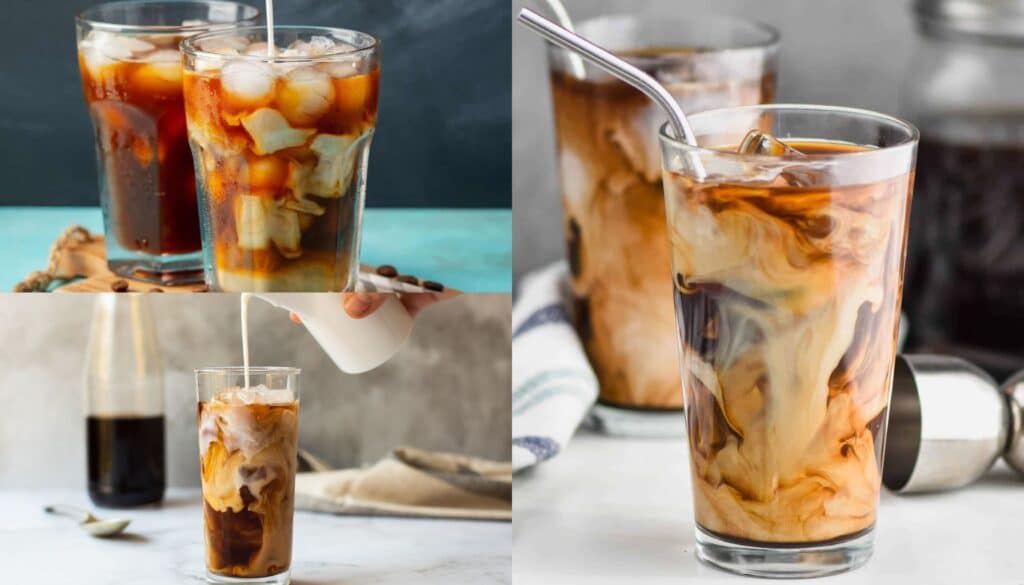
Overview of the Process
Making iced coffee involves brewing coffee using any preferred method, cooling it down, and then serving it over ice. The goal is to create a refreshing, chilled beverage that retains the rich flavors of coffee without becoming too diluted. Depending on the method, the taste, caffeine content, and preparation time can vary significantly.
Different Methods of Preparation
Traditional Iced Coffee
- Process: Traditional iced coffee is made by brewing coffee at a regular strength or slightly stronger than usual to counteract the dilution caused by ice. Once brewed, the coffee is cooled to room temperature or refrigerated until cold. It’s then served over ice and can be flavored with milk, sweetener, or syrups according to taste.
- Taste: Can vary widely depending on the coffee blend and brewing method used, but it tends to retain the acidity and full-bodied flavor of hot brewed coffee.
- Caffeine Content: Comparable to regular brewed coffee, though it may be slightly diluted by the ice.
- Preparation Time: Varies depending on cooling method; can be instant if poured hot over ice or take several hours if cooled in the fridge.
Cold Brew
- Process: Cold brew is made by steeping coarsely ground coffee in cold water for an extended period, usually 12 to 24 hours, either at room temperature or in the refrigerator. The mixture is then strained to remove the coffee grounds. The resulting concentrate can be diluted with water or milk and served over ice.
- Taste: Generally smoother and less acidic than traditional iced coffee, with a naturally sweeter profile.
- Caffeine Content: Often higher than traditional iced coffee due to the long steeping time and the concentration of the coffee, though this can vary based on dilution.
- Preparation Time: Requires planning ahead due to the long steeping time but involves minimal active preparation.
Japanese-Style Iced Coffee
- Process: Also known as flash brewing, this method involves brewing coffee directly over ice using a pour-over method or drip coffee maker. The hot coffee drips onto the ice, cooling it instantly and locking in the flavors.
- Taste: Tends to highlight the coffee’s aromatic qualities and preserves the acidity, offering a balance that’s closer to hot brewed coffee compared to cold brew.
- Caffeine Content: Similar to that of traditional brewed coffee since it’s brewed hot and quickly cooled, maintaining a high level of caffeine.
- Preparation Time: Relatively quick, as it only takes as long as brewing a regular hot coffee plus the setup time for ice.
Comparison of Taste, Caffeine Content, and Preparation Time
The choice between traditional iced coffee, cold brew, and Japanese-style iced coffee often comes down to personal preference for taste, desired caffeine level, and preparation time available.
- Taste: Traditional iced coffee offers a taste closest to that of its hot counterpart, with a wider range of acidity and bitterness. Cold brew provides a smooth, sweet, and mellow flavor with less acidity. Japanese-style iced coffee strikes a balance, preserving the coffee’s brightness and aroma.
- Caffeine Content: Cold brew usually has the highest caffeine content due to its concentration, followed by Japanese-style and traditional iced coffee. However, caffeine levels can be adjusted based on coffee-to-water ratios and dilution preferences.
- Preparation Time: Japanese-style iced coffee is the quickest to prepare, followed by traditional iced coffee (if using the hot-over-ice method). Cold brew requires the most extended preparation time due to the long steeping process.
Each method has its unique characteristics, offering a range of options for coffee lovers to enjoy their favorite drink cold.
Variations of Iced Coffee Around the World
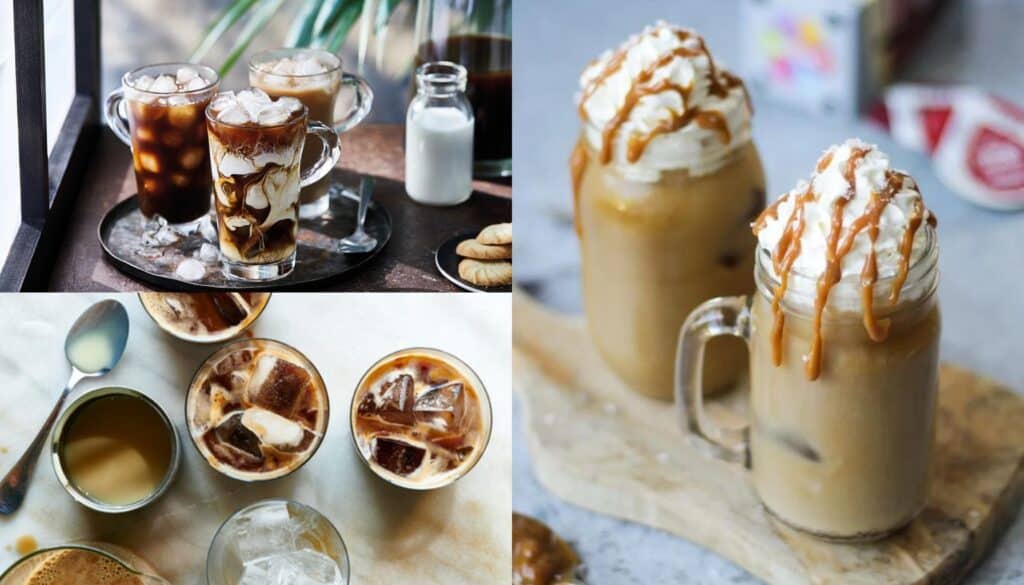
Overview of How Different Cultures Enjoy Iced Coffee
Iced coffee is a global phenomenon, with each culture adding its unique twist to the basic concept of chilled coffee. These variations reflect local tastes, climate conditions, and coffee traditions, making iced coffee a versatile and universally beloved beverage. From the sweet and strong Vietnamese iced coffee to the creamy and rich Australian version, the diversity of iced coffee around the world is a testament to the adaptability and enduring popularity of coffee.
Highlight of Countries and Their Unique Take on Iced Coffee
Vietnamese Iced Coffee (Cà Phê Đá)
- Description: This potent and sweet coffee is made from strong, dark roast Vietnamese coffee dripped through a metal filter (phin) into a glass containing a layer of sweetened condensed milk. The coffee and milk mixture is then poured over ice.
- Unique Features: The use of sweetened condensed milk, not just as a sweetener but also as a creamer, sets this version apart. The slow drip brewing process creates a strong coffee that, when mixed with the creamy milk, offers a perfect balance of strength and sweetness.
Greek Frappe
- Description: The Greek frappe is a frothy iced coffee drink made from shaken instant coffee, water, sugar, and ice. Milk may be added for a creamier texture. It’s served in a tall glass with a straw.
- Unique Features: What makes the frappe distinctive is its frothy top layer, achieved by shaking the ingredients vigorously. This method produces a light and refreshing drink, perfect for the hot Greek summers.
Italian Shakerato
- Description: The Shakerato is an Italian iced coffee classic, made by vigorously shaking a shot of espresso (sometimes sweetened or flavored with syrup) with ice in a cocktail shaker until it becomes frothy. It’s then strained into a chilled glass.
- Unique Features: The process of shaking not only chills the coffee but also introduces air, creating a smooth, frothy texture. This method highlights the espresso’s flavor, making it a refined, cold coffee choice.
Australian Iced Coffee
- Description: Australian iced coffee is far richer than most other versions. It typically consists of chilled coffee poured over ice, accompanied by milk and often topped with a scoop of vanilla ice cream and whipped cream.
- Unique Features: The inclusion of ice cream and sometimes whipped cream on top makes this more of a dessert coffee. Unlike other iced coffees that focus on the coffee’s strength or the addition of sweeteners, the Australian version is a decadent treat that combines the flavors of coffee, milk, and ice cream.
Each of these variations of iced coffee not only offers insight into the coffee drinking habits of different cultures but also illustrates the innovative ways in which coffee can be enjoyed. Whether you prefer your iced coffee strong and sweet, light and frothy, shaken and smooth, or rich and creamy, there’s a version from around the world that’s sure to delight your taste buds.
Ingredients and Flavors

Common Ingredients Used in Making Iced Coffee
The basic ingredients for making iced coffee include coffee, water, and ice. However, the beauty of iced coffee lies in its adaptability, allowing for a wide range of ingredients to customize flavor and texture. Beyond the basics, ingredients such as milk or milk alternatives, sweeteners, and flavorings play significant roles in crafting the perfect cup of iced coffee tailored to individual tastes.
Popular Flavor Variations and Additions
Sweeteners:
- Sugar: The most straightforward option for adding sweetness to iced coffee. Both granulated and powdered sugars are used, with the latter dissolving more easily in cold liquids.
- Syrups: Flavored syrups offer endless possibilities for customizing iced coffee. Vanilla, caramel, hazelnut, and chocolate syrups are among the most popular, allowing for both sweetness and flavor in one addition.
- Honey: A natural sweetener that adds a distinct flavor. Honey pairs well with darker roasts and can complement the natural bitterness of coffee.
- Agave Nectar: A vegan-friendly sweetener that dissolves easily in cold beverages, offering a subtle sweetness without overpowering the coffee.
Milk and Milk Alternatives:
- Whole Milk: Adds richness and creaminess, softening the coffee’s bitter edges and contributing to a smoother texture.
- Skim or Low-Fat Milk: Offers a lighter option for those looking to enjoy iced coffee without the added richness of whole milk.
- Plant-Based Milks: Almond, soy, oat, and coconut milk are popular alternatives for those avoiding dairy. Each offers a unique flavor profile and level of creaminess, with oat milk being particularly noted for its ability to froth and blend well with coffee.
- Condensed or Evaporated Milk: Used in specific recipes like Vietnamese iced coffee for a sweet, creamy taste.
Spices and Extracts:
- Cinnamon: A dash of cinnamon can add warmth and spice, complementing the coffee’s natural flavors.
- Vanilla Extract: Adds a sweet, aromatic flavor that pairs beautifully with both the coffee and any added milk or sweeteners.
- Cardamom: Popular in Middle Eastern coffee, cardamom adds a unique, slightly spicy flavor to iced coffee.
- Cocoa Powder: For a hint of chocolate without the sweetness of syrup, cocoa powder can provide a deep, rich flavor.
Experimenting with Flavors
Creating the perfect iced coffee often involves experimenting with different combinations of these ingredients to find the balance that suits your taste best. Whether you prefer your iced coffee sweet and flavored or strong and straightforward, the versatility of iced coffee allows for endless customization. From the simple addition of a splash of milk to elaborate concoctions involving multiple syrups and spices, iced coffee can be tailored to fit any flavor preference or dietary need.
Health Aspects of Iced Coffee
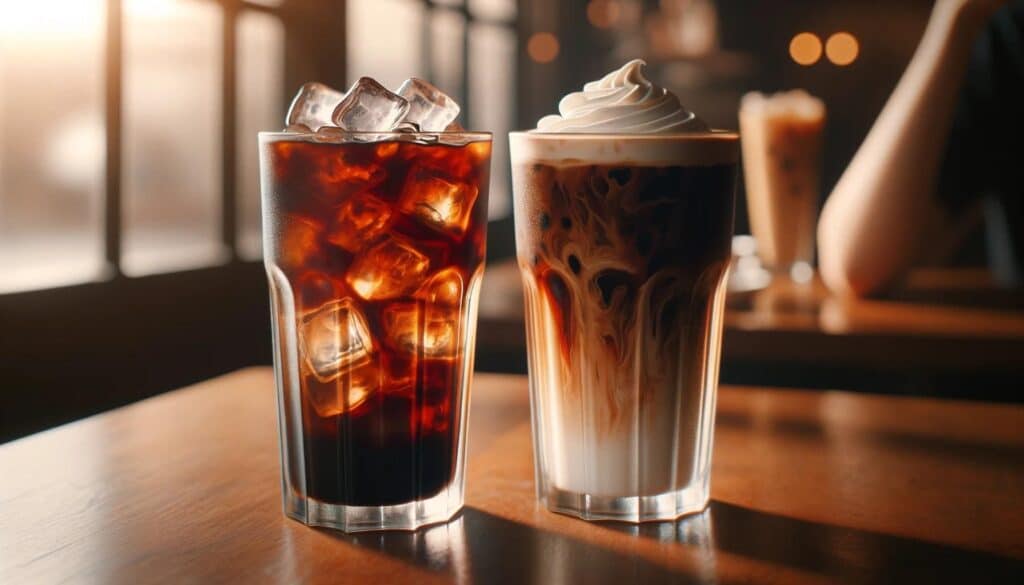
Iced coffee, in its simplest form (coffee and ice), is a low-calorie beverage that can be a healthy part of one’s diet. However, the health implications can vary significantly based on the added ingredients like milk, sweeteners, and flavorings. Understanding the nutritional content and health impacts of various iced coffee preparations can help consumers make informed choices.
Comparison of Calorie and Sugar Content in Various Iced Coffee Preparations
- Plain Iced Coffee: Virtually calorie-free and sugar-free when consumed black, making it an excellent choice for those monitoring calorie intake.
- Iced Coffee with Sugar and Milk: The addition of sugar and whole milk can significantly increase the calorie and sugar content. For example, adding one tablespoon of sugar (48 calories) and one-quarter cup of whole milk (37 calories) to iced coffee totals approximately 85 additional calories.
- Flavored Iced Coffee Drinks (e.g., Iced Lattes, Mochas, Frappuccinos): These can vary widely in calorie and sugar content, with some commercial preparations containing several hundred calories and significant amounts of sugar—sometimes exceeding 50 grams (or 12 teaspoons) per serving.
- Iced Coffee with Plant-Based Milk: Substituting dairy milk with almond, soy, or oat milk can alter the calorie content, generally lower than whole milk but varying by product, especially if sweetened versions of these milks are used.
- Iced Coffee with Alternative Sweeteners: Using sweeteners like stevia, monk fruit, or erythritol can keep the sugar content low while still providing sweetness. However, perceptions of sweetness and personal preference for taste can vary.
Benefits of Consuming Iced Coffee
- Antioxidants: Coffee is a rich source of antioxidants, which can combat inflammation and protect against certain diseases.
- Improved Mental Focus: The caffeine in iced coffee can enhance alertness, concentration, and mood.
- Physical Performance: Caffeine increases adrenaline levels and releases fatty acids from fat tissues, potentially improving physical performance.
Drawbacks of Consuming Iced Coffee
- Increased Calorie and Sugar Intake: Highly sweetened and creamy iced coffee drinks can contribute to weight gain and interfere with blood sugar management.
- Caffeine Sensitivity: Individuals sensitive to caffeine may experience insomnia, jitteriness, or heart palpitations. It’s essential to monitor caffeine intake, especially in the afternoon or evening.
- Bone Health: Excessive consumption of caffeine can interfere with calcium absorption, impacting bone density over time.
Iced coffee, like many foods and beverages, can fit into a healthy lifestyle when consumed in moderation and with attention to added ingredients. Opting for minimal added sugars and fats can keep iced coffee a refreshing, low-calorie choice. However, indulging in the richer, sweeter versions as an occasional treat rather than a daily habit can help maintain a balanced diet and healthy lifestyle.
Making Iced Coffee at Home
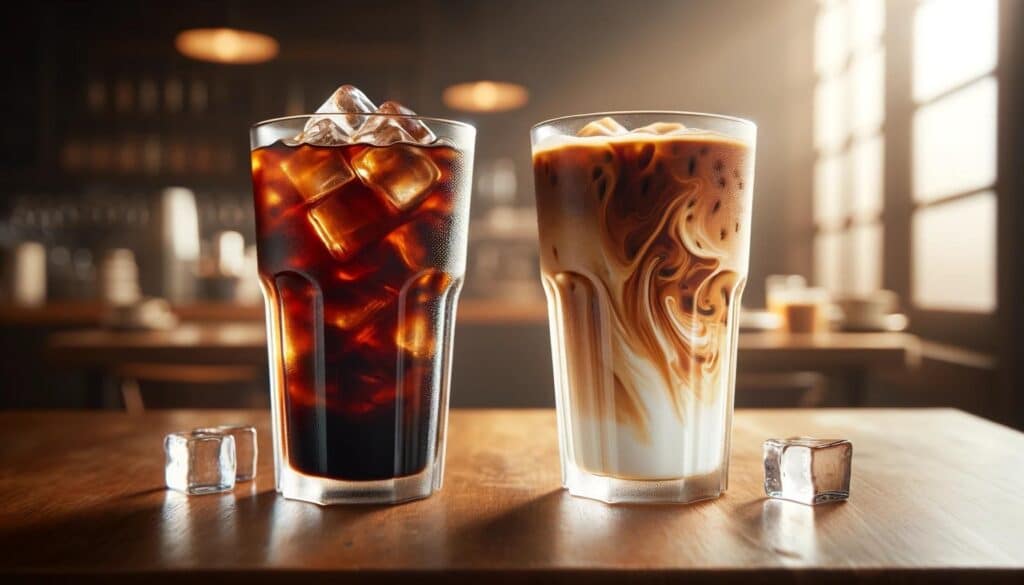
Basic Recipe for Making a Simple Iced Coffee
Ingredients:
- 1 cup of freshly brewed coffee (stronger than usual to account for dilution from ice)
- Ice cubes
- Optional: Milk, sweetener, or syrup to taste
Instructions:
- Brew Coffee: Start by brewing your coffee a bit stronger than you would for hot coffee. This compensates for the dilution that occurs when the coffee is poured over ice. Use about 1.5 times the amount of coffee you would normally use.
- Cool the Coffee: Allow the coffee to reach room temperature naturally, or place it in the refrigerator to cool faster. This step helps prevent the ice from melting too quickly when you pour the coffee over it.
- Prepare Your Cup: Fill a tall glass with ice cubes to about three-quarters full.
- Combine: Pour the cooled coffee over the ice-filled glass.
- Customize: Add milk, sweetener, or syrup according to your preference. Stir well.
- Serve: Enjoy your homemade iced coffee immediately.
Tips for the Perfect Homemade Iced Coffee
- Use Quality Coffee Beans: The flavor of your iced coffee heavily depends on the quality of the beans. Use freshly ground coffee beans for the best taste.
- Cool Before Icing: Allow your brewed coffee to cool before adding it to ice. This prevents the coffee from becoming too watery.
- Experiment with Brew Methods: Experiment with different brewing methods (e.g., French press, drip, pour-over) to find the one that best suits your taste for iced coffee.
- Ice Matters: Use large ice cubes that melt slowly to minimize dilution. Consider making coffee ice cubes by freezing brewed coffee in an ice cube tray.
- Cold Brew for a Smoother Taste: If you prefer a smoother, less acidic drink, try making a cold brew concentrate that you can dilute with water or milk and serve over ice.
How to Customize Your Drink to Match Your Taste
- Sweetness: Adjust the sweetness by adding sugar, simple syrup, honey, or artificial sweeteners. For a unique twist, try flavored syrups like vanilla, caramel, or hazelnut.
- Milk: Experiment with different types of milk (dairy and plant-based) to change the texture and flavor of your iced coffee. Full-fat milk adds richness, while almond or oat milk offers a nutty flavor.
- Flavors: Add spices such as cinnamon, nutmeg, or cocoa powder directly to the brewing coffee for a flavored iced coffee. Vanilla extract or almond extract can also add a pleasant aroma and taste.
- Toppings: For an extra special touch, top your iced coffee with a dollop of whipped cream, a sprinkle of chocolate shavings, or a drizzle of caramel sauce.
Making iced coffee at home allows for endless creativity and customization. By starting with a simple base and experimenting with different add-ins and techniques, you can craft the perfect iced coffee to suit your personal taste preferences, making every sip uniquely satisfying.
The Role of Iced Coffee in Modern Culture

Iced Coffee as a Lifestyle Choice and Fashion Statement
Iced coffee has grown from a simple drink to a symbol of modern lifestyle and fashion, especially among young people. It’s now more than just a way to get caffeine; it’s a way to show who you are and your sense of style. This change has a lot to do with the growing specialty coffee culture, which focuses on fancy preparation, high-quality ingredients, and enjoying the coffee experience. Iced coffee fits right in because you can change it up in so many ways, letting people show off their personal tastes in public.
The look of iced coffee, with its clear cup full of ice and the beautiful layers of coffee and cream, turns it into something like a fashion accessory. Carrying a carefully made iced coffee can be as stylish as wearing trendy clothes or jewelry, showing you’re part of the modern, city-loving, and health-aware crowd.
Iced Coffee in Social Media, Marketing, and Pop Culture
Social Media: Iced coffee has become huge on social media, where influencers, celebrities, and regular folks share their daily coffee moments. Instagram and TikTok are full of amazing iced coffee pictures and videos, from simple morning coffee posts to detailed guides on making the perfect iced drink. The hashtag #IcedCoffee alone has millions of posts. This social media fame has really helped make iced coffee a trendy and sought-after drink.
Marketing: Seeing how popular iced coffee is, brands are using it to attract young, style-conscious people. Their ads show iced coffee as convenient, fashionable, and customizable, perfect for anyone with a busy, social life. Coffee shops, big and small, keep coming up with new iced coffee flavors and special drinks to keep customers interested and coming back.
Pop Culture: Iced coffee has also become a favorite in TV shows, movies, and music videos, chosen by characters who want to look cool and active. It’s in songs and often in the hands of celebrities caught by photographers, making it even more of a cultural icon.
Iced coffee’s role in today’s culture is more than just a drink. It’s a trend that shows what a generation values: being unique, caring about looks, and making thoughtful choices. Its ability to be customized has made iced coffee a way for people to express themselves, connect with others, and stay in tune with what’s current.
Conclusion
Iced coffee shows how versatile and creative coffee lovers around the world can be. Its charm comes not just from being refreshing but also from how you can change it to fit your own taste. This has made iced coffee a favorite in many cultures and climates. You can enjoy the strong and sweet Vietnamese iced coffee or the smooth and frothy Greek frappe. The wide variety of iced coffee types shows how much people everywhere love their coffee cold.
What really makes iced coffee special is how you can change it up. You can keep it simple with just coffee and ice, or make it fancy with spices, syrups, and milk adding layers of flavor. This ability to transform makes iced coffee a source of new ideas in the kitchen, always showing off local flavors and what’s in season.
Iced coffee has also become a big part of modern culture. It’s more than a drink—it’s a way of life, a fashion choice, and a hit on social media. It shows off what’s cool and stylish in today’s world. Its spot in ads and pop culture makes it a symbol of elegance and trendiness.
Looking at how iced coffee has gone from a simple cool drink to a worldwide icon of culture, it’s obvious its story keeps growing. Every new twist on iced coffee keeps winning over coffee fans everywhere. Whether you’ve loved iced coffee for years or are just starting to explore, now is the perfect time to try out different flavors and styles. So, go ahead, play with different iced coffee recipes, and maybe you’ll discover your new favorite. In the big world of iced coffee, there’s a perfect drink for everyone waiting to be found.
Frequently Asked Questions about Iced Coffee
1. Can I make iced coffee with espresso instead of regular brewed coffee?
Answer: Absolutely! Using espresso to make iced coffee results in a richer, more concentrated flavor profile. Simply pull a shot or two of espresso and let it cool slightly before pouring it over ice. You can add cold water or milk to adjust the strength to your liking. This method is perfect for those who prefer a stronger coffee base and is a great way to make an iced Americano or iced latte.
2. Is there a difference in caffeine content between iced coffee and hot coffee?
Answer: The caffeine content in coffee primarily depends on the coffee beans and brewing method, not the temperature at which the coffee is served. However, because iced coffee, especially cold brew, is often made with a higher coffee-to-water ratio than its hot counterpart, it can contain more caffeine. Keep in mind that dilution with ice or added milk can affect the perceived strength and caffeine content of your drink.
3. How can I prevent my iced coffee from becoming diluted as the ice melts?
Answer: A popular solution is to make ice cubes out of coffee instead of water. This way, as the ice melts, it simply adds more coffee instead of water to your drink, keeping it strong and flavorful. Another tip is to cool your coffee to room temperature before adding it to the ice, reducing the rate at which the ice melts.
4. What’s the best coffee roast to use for making iced coffee?
Answer: The best roast for iced coffee comes down to personal preference, but medium to dark roasts tend to be favored for their bold, robust flavor that stands up well to the dilution from ice. Lighter roasts can be used for a brighter, more acidic drink, particularly appealing in preparations like Japanese-style iced coffee, where the nuances of the coffee are more pronounced.
5. Can I use flavored coffees to make iced coffee?
Answer: Absolutely! Flavored coffees can add an interesting twist to your iced coffee without needing additional syrups or sweeteners. From vanilla and hazelnut to more exotic flavors like coconut or caramel, flavored coffees can provide a subtle or pronounced taste, depending on the brewing strength. Just be mindful of balancing the flavors if you’re adding other ingredients like milk or sweeteners to ensure they complement rather than overpower each other.
